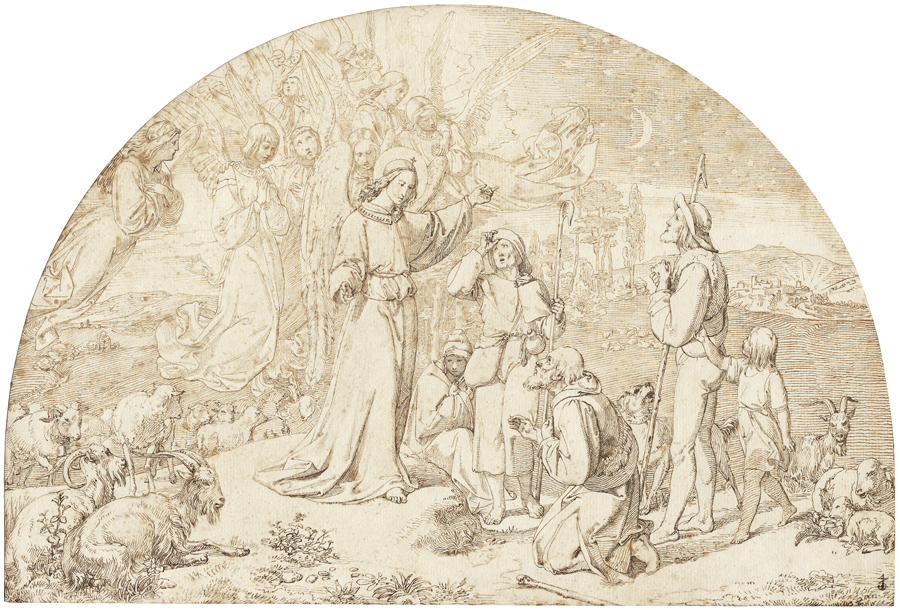Loading the page ...
Joseph von Führich
(1800 Kratzau – 1876 Vienna)
The Adoration of the Shepherds. Pen and brown ink. 26.2 x 38.7 cm. Circa 1824–30. Monogrammed. Wörndle 197.
Born in the north Bohemian town of Kratzau (now Chrastava), the artist was first taught by his father, Wenzel Führich. In 1819, Führich scored a great succès d’estime with two pictures he contributed to the annual exhibition of the Prague Academy. Sponsored by Count Christian Clam-Gallas, he began to study art at that same Academy the following year. In the early 1820s Führich was intensely preoccupied with the ideas of the Romantic movement, reading Novalis, Tieck, Wackenroder and the writings of the two Schlegel brothers, while also distinguishing himself as an illustrator. His illustrations for Tieck’s Genoveva, on which the artist worked in the years 1824–25, turned out to be a great artistic success and, thanks to the intervention of Prince Metternich, earned him a grant for a study trip to Italy. Early in 1827 Führich arrived in Rome, where he moved in the circle of German artists who met in the Café Greco, and made the acquaintance, through Joseph Anton Koch, of the Nazarenes Julius Schnorr von Carolsfeld, Philipp Veit and Friedrich Overbeck. This connection turned out to be so fruitful and inspiring that Führich soon joined the Brotherhood of Saint Luke and identified himself completely with its artistic and religious activities. From 1827 to 1829, Führich took part, under the supervision of Overbeck, in the completion of the frescoes in the Tasso Hall in the Casino Massimo before returning to Prague in summer 1829. In his autobiography, published in 1844, Führich movingly describes his last days in Rome: "My friends had prepared for me a farewell supper, which all the more serious German artists attended ... The farewell took place in one of the most beautifully situated inns outside Porta Salara, with a lovely view over the Campagna towards the Sabine and Latian Hills; cheerful nostalgia was the prevailing mood, which soon spread to the whole company. My friends saw me home by torchlight" (quoted after M. Bernhard, Deutsche Romantik Handzeichnungen, Munich 1973, vol. I, p. 432).
The Adoration of the Shepherds is an artistically significant example of Führich’s early drawing style. The work also documents the variety and range of his artistic sources of inspiration. During his academic training in Prague Führich was heavily influenced by old German art and the drawings of Albrecht Dürer. Later in Rome he devoted himself intensely to the study of Italian Renaissance painting and, under the influence of Overbeck, found himself drawn to the artistic ideals of the Nazarenes, whose most prominent Austrian representative he subsequently became. Although Heinrich von Wörndle dated the present drawing at about 1824, an exact chronological assignment is difficult. Because of its stylistic proximity to the drawings of the Roman period, the Adoration of the Shepherds could equally well have been done some years later, say 1827–28 (fig. 1). Führich was an excellent draughtsman, and all the works he produced after 1824 demonstrate impressive clarity and accuracy of line. Our sheet owes its effect to its masterly composition. The interaction between the angelic host, the Archangel and the astonished shepherds is presented with great subtlety and clarity. Each figure is given its own individual expression and gestures. The same applies to the animals of the herd, which are characterized vividly and with loving attention to detail. The transition from the group of figures in the foreground to the wide southern landscape in the background, stretched out under the starry night sky, is managed with great harmony and spatial dexterity.
Führich’s penwork is extremely concentrated and succinct throughout. He achieves rich tonal gradations by means of subtle variations in the thickness of line and employs a wide variety of hatching patterns to great effect. The wonderfully light and transparently sketched angels are inspired by Albrecht Dürer, whose accurate drawing style they reflect. At the same time, in his striving for graphic refinement and his purism of line Führich shows himself to be true to the ideals of the Nazarene movement.
